|
|
Updated as per James P. Tuttle's The Hawk Moths of North America, October 2009
Updated as per personal communication with Wallace B. Thompson, October 2009
|
Northern Texas
Sphingidae
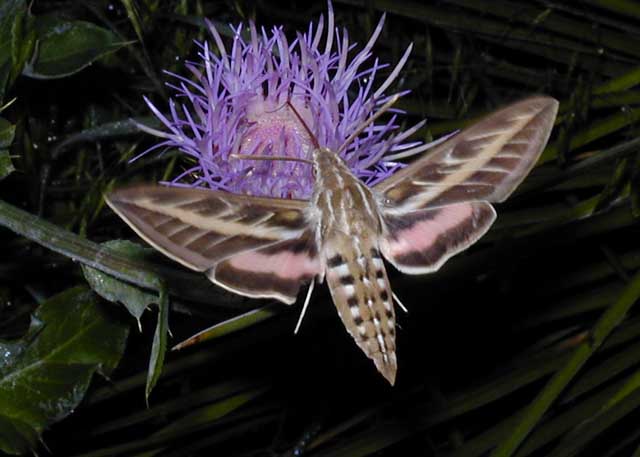
Hyles lineata, Borger, Hutchinson County, Texas, courtesy of
Wallace B. Thompson.
This page is inspired by and dedicated to
Wallace B. Thompson who sent me the picture of
Hyles lineata from Borger (Hutchinson County) at the top
of this page. Wallace also forwarded images of larvae of
Hyles lineata, Hemaris diffinis and what I believe is a heavily parasitized
Paratrea plebeja. Those pictures are posted on the larva thumbnail page for
northern Texas.
In September, 2011, Wallace sent me images of an Hemaris diffinis adult, as well as images of adult and larva of Eumorpha achemon.
Seventy-five Sphingidae species are listed for Texas on the U.S.G.S.
website. Not all of the species are reported or anticipated in
the northern region.
It is hoped
that this checklist, with the thumbnails and notes, will help you
quickly identify the moths you are likely to encounter.
A "USGS"
indicates the moth is reported on the USGS website and/or in
Lepidoptera of North America, #1. Distribution of Silkmoths (Saturniidae) and Hawkmoths (Sphingidae)
of Eastern North America,
an excellent little booklet available through Paul Opler.
Please help me develop this list with improved, documented accuracy
by sending sightings (species, date, location), preferably with an
electronic image, via email to
Bill Oehlke.
The night-blooming moon flower will attract many
Sphingidae at dusk and into the night.
Sphinginae subfamily
Sphingini tribe:
 |
Agrius cingulata,
WO Pink-spotted hawkmoth.
This species is a strong migrant and adults nectar from
deep-throated flowers including moonflower (Calonyction aculeatum),
morning glory (Convolvulus), honey suckle (Lonicera)
and petunia (Petunia species). doubtful, usually just southern half of Texas
|
 |
Ceratomia amyntor
WO,
the Elm Sphinx or Four-horned Sphinx.
The upperside of the forewing is brown with dark brown and white markings including a white costal area near the wing base, dark streaks along the veins,
and a white spot in the cell.
Larvae feed on Elm (Ulmus), birch (Betula), basswood (Tilia), and
cherry (Prunus). doubtful, usually northeastern Texas |
 |
Ceratomia catalpae
WO,
the Catalpa Sphinx.
The upperside of the forewing is yellowish brown with no white markings, but there are indistinct black lines and dashes. The cell spot is gray with a black outline. The larvae feed in large groups and are much more
spectacular than the moths.
Catalpa is the larval host.
generally more eastern species |
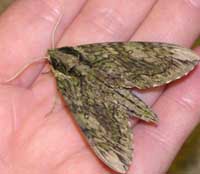 |
Ceratomia hageni
WO,
Hagen's Sphinx or Osage Orange Sphinx.
The upperside of the forewing is gray with a green tint and has dark
indistinct wavy lines, and pale gray patches at the wing tip and
along the costa. generally more eastern species |
 |
Ceratomia undulosa
WO, the Waved
Sphinx.
The upperside of the forewing is pale brownish gray with wavy black
and white lines and a black-outlined white cell spot. The upperside
of the hindwing is gray with diffuse darker bands. doubtful, usually more easterly |
 |
I suspect if you grow tomatoes, you are likely to encounter Manduca quinquemaculatus.
|
 |
Manduca rustica
WO, the Rustic Sphinx.
Look for three large yellow spots
on each side of the abdomen. The upperside of the forewing is
yellowish brown to deep chocolate brown with a dusting of white
scales and zigzagged black and white lines. generally more eastern and southerly.
|
 |
If you grow tomatoes, you have probably encountered Manduca sexta
in the larval stage.
Larvae get very large and can strip a tomato plant.
|
 | The upperside of the forewing is gray with indistinct black and
white markings. There is a series of black dashes
from the base to the tip, and a small white cell spot.
|
Paratrea plebeja larva, Borger, Hutchinson County, Wallace B. Thompson
 |
Sphinx chersis
WO, the Northern Ash Sphinx or Great Ash
Sphinx
The upperside of the forewing is soft dark gray to
blue-gray with a series of black dashes, one of which reaches the
wing tip.
Larval hosts are ash, lilac, privet, cherry, and quaking aspen.
|
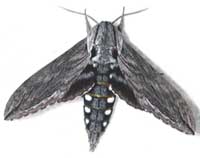 | The upperside of the forewing is pale blue-gray to dark gray with a black dash reaching the wing tip and
a white stripe along the lower outer margin.
The upperside of the hindwing is black with two diffuse white
bands, the upper one being practically non-existent.
|
Smerinthini Tribe:
 |
The adults are also highly variable; sometimes wings of an individual
may be all one color or may have several colors, ranging from pale to
dark brown, and may have a white or pink tinge. Patterns range from
faint to pronounced.
See the file for the female; she is different. |
 |
Pachysphinx modesta
WO,
the Modest Sphinx or Poplar Sphinx
They are common on Prince Edward Island, and larvae
feed on poplars and willows.
|
Macroglossinae subfamily
Dilophonotini tribe:
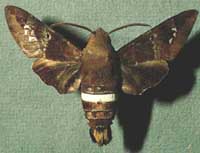 |
The body is dark brown with a wide white
band across the abdomen. Wings are dark brown. The forewing has a
black cell spot and 3 white spots near the pale brown marginal
area. unlikely stray |
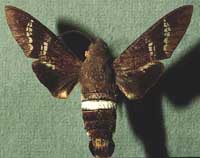 |
The body is brown with a wide white band across the abdomen. The
upperside of wings is dark brown; the forewing has two bands of pale
spots and lacks a black spot (typical of clavipes) at the end of the
cell. unlikely stray |
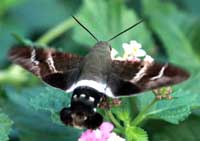 |
The body is dark brown with a wide white stripe across the abdomen.
The wings are dark brown. It is very similar to above species, but the
upperside of the hindwing has
pale patches along the costa and inner margin. unlikely stray |
 |
Hemaris diffinis
WBT, the
Snowberry Clearwing or Bumblebee Moth
Adults mimic bumblebees and are quite variable. The wings are basically clear, with dark brown to
brownish-orange veins, bases and edges. The thorax is golden-brown to
dark greenish-brown. The abdomen tends to be dark (black) with 1-2
yellow segments before the tip.
|
Hemaris diffinis larva and adult, Borger, Hutchinson County, Wallace B. Thompson
Philampelini tribe:
 |
Larvae get large and feed on grape vines and Virginia creeper.
Note the differences between this moth and the Pandorus Sphinx. |
Eumorpha achemon larva and adult, Borger, Hutchinson County, Wallace B. Thompson
Macroglossini tribe:
 |
Darapsa myron
WO, the Virginia Creeper Sphinx or the Grapevine Sphinx
If you have the
foodplants indicated in the common names, you probably have this
species nearby. The lower wings are orange.
|
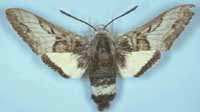 |
Euproserpinus wiesti adults fly, during the day, over sand washes
and prairie
blow-outs as a single brood from May-June.
|
 |
Hyles lineata
WBT, the White-lined Sphinx
This species has
strong migrating tendancies from much further south.
There are records from New Hampshire and Maine. |
Hyles lineata, Bergor, Hutchinson County, Wallace B. Thompson.
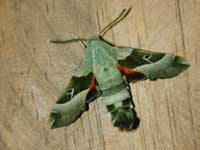 |
The upperside of the forewing is pale gray-green with a deep
green-brown median area and a white dash at the wing tip.
rare
|
|
|
|
Enjoy some of nature's wonderments, giant silk moth cocoons.
These cocoons are for sale winter and fall. Beautiful Saturniidae moths will emerge the following spring and summer.
Read Actias luna rearing article. Additional online help available.
Use your browser "Back" button to return to the previous page.
This page is brought to you by
Bill Oehlke and the
WLSS. Pages are on space rented from Bizland. If you would like
to become a "Patron of the Sphingidae Site", contact Bill.
Please send sightings/images to Bill. I will do my best to respond to
requests for identification help.
 | 
Show appreciation for this site by clicking on flashing butterfly to the left.
The link will take you to a page with links to many insect sites. |
This website has been created and is maintained by Bill Oehlke without government or institutional financial assistance. All expenses, ie., text reference
support material, webspace rental from Bizland, computer repairs/replacements, backups systems, software for image adjustments (Adobe Photoshop; L-View),
ftp software, anti-virus protection, scanner, etc. are my own.
I very much appreciate all the many images that have been sent to me, or of which I have been granted permission to copy and post from other websites.
All images on this site remain the property of respective photographers.
If you would like to contribute to the maintenace of this website by sending a contribution to
Bill Oehlke
Box 476
155 Peardon Road
Montague, Prince Edward Island, C0A1R0
Canada
your donation would be much appreciated and would be used for
1) paying for webspace rental;
2) paying for computer maintenance and software upgrades;
3) purchases of additional text reference material (journals and books) in anticipation of expanding the site to a worldwide Sphingidae site;
4) helping to pay my daughter's tuition; with anything left over going to humanitarian aid.
If you are mailing a check from USA, please use $0.85 postage. Donations can also be made through Paypal via the button below.


